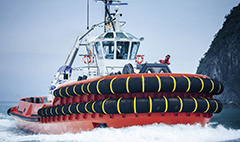How Tugboat Works
A tug (tugboat or towboat) is a type of vessel that maneuvers other vessels by pushing or pulling them either by direct contact or by means of a tow line. Tugs typically move vessels that either are restricted in their ability to maneuver on their own, such as ships in a crowded harbor or a narrow canal, or those that cannot move by themselves, such as barges, disabled ships, log rafts, or oil platforms. Tugboats are powerful for their size and strongly built, and some are ocean-going. Some tugboats serve as icebreakers or salvage boats. Early tugboats had steam engines, but today most have diesel engines. Many tugboats have firefighting monitors, allowing them to assist in firefighting, especially in harbors.
Tugboat engines typically produce 500 to 2,500 kW (~ 680 to 3,400 hp), but larger boats (used in deep waters) can have power ratings up to 20,000 kW (~ 27,200 hp). Tugboats usually have an extreme power:tonnage-ratio; normal cargo and passenger ships have a P:T-ratio (in kW:GRT) of 0.35 to 1.20, whereas large tugs typically are 2.20 to 4.50 and small harbour-tugs 4.0 to 9.5. The engines are often the same as those used in railroad locomotives, but typically drive the propeller mechanically instead of converting the engine output to power electric motors, as is common for diesel-electric locomotives. For safety, tugboats' engines often feature two of each critical part for redundancy.
A tugboat is typically rated by its engine's power output and its overall bollard pull. The largest commercial harbour tugboats in the 2000s-2010s, used for towing container ships or similar, had around 60 to 65 short tons-force (530–580 kN) of bollard pull, which is described as 15 short tons-force (130 kN) above "normal" tugboats. More details
Tugboat engines typically produce 500 to 2,500 kW (~ 680 to 3,400 hp), but larger boats (used in deep waters) can have power ratings up to 20,000 kW (~ 27,200 hp). Tugboats usually have an extreme power:tonnage-ratio; normal cargo and passenger ships have a P:T-ratio (in kW:GRT) of 0.35 to 1.20, whereas large tugs typically are 2.20 to 4.50 and small harbour-tugs 4.0 to 9.5. The engines are often the same as those used in railroad locomotives, but typically drive the propeller mechanically instead of converting the engine output to power electric motors, as is common for diesel-electric locomotives. For safety, tugboats' engines often feature two of each critical part for redundancy.
A tugboat is typically rated by its engine's power output and its overall bollard pull. The largest commercial harbour tugboats in the 2000s-2010s, used for towing container ships or similar, had around 60 to 65 short tons-force (530–580 kN) of bollard pull, which is described as 15 short tons-force (130 kN) above "normal" tugboats. More details

